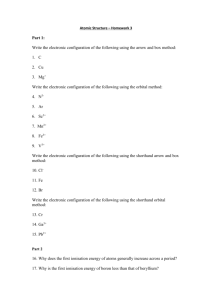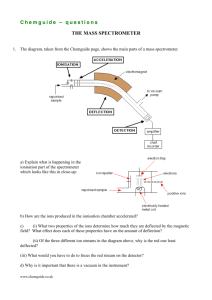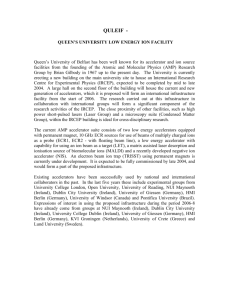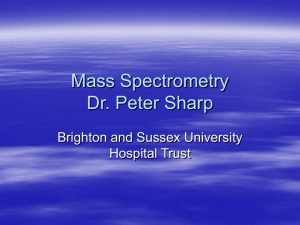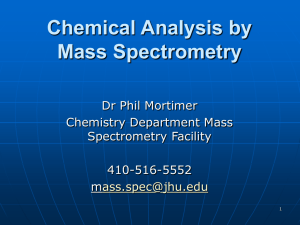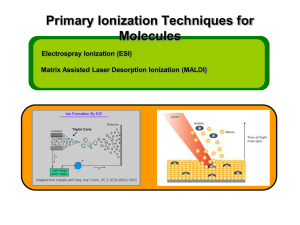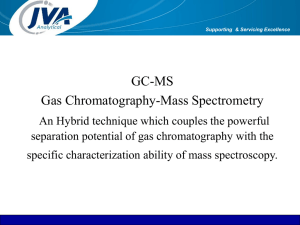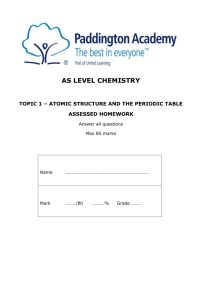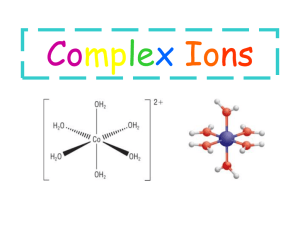Mass Spec I
advertisement
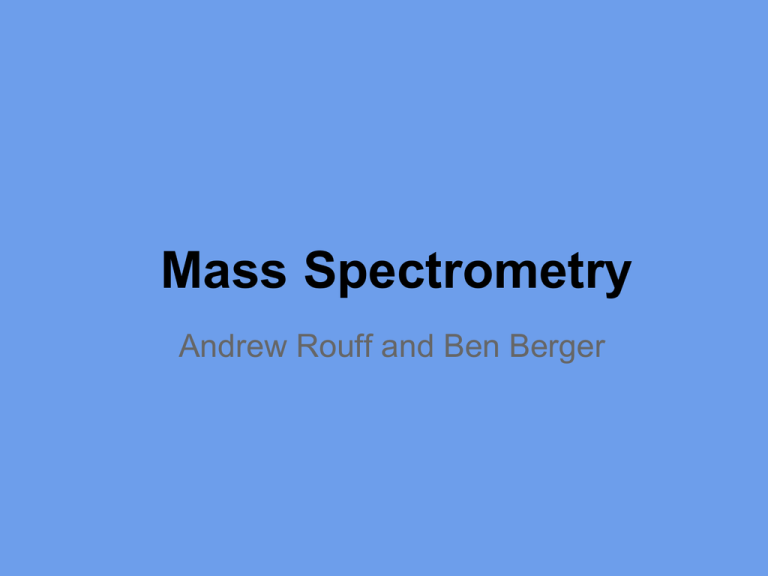
Mass Spectrometry Andrew Rouff and Ben Berger A Brief History 1897- JJ Thomson recorded first mass-to-charge ratio of electrons 1951- W. Pauli and H. Steinwedel developed first quadrupole mass spectrometer 1959- K. Biemann applies electron ionisation mass spectrometry 1974- B. Mamyrin contributes to time-of-flight mass spectrometry 1988- K. Tanaka develops MALDI, receives Nobel prize in Chemistry Parts of a Mass Spectrometer 1. A sample injector 2. An ionisation chamber 3. A mass analyser 4. An ion detector 5. A data handling facility Mass Spec. For Dummies ● ● ● ● ● ● Cations are produced Cations are accelerated in instrument Magnetic field is introduced Amount of “bend” is measured The heavier an ion is, the less it will “bend” Mass/charge ratio is then calculated http://www.astarmathsandphysics.com/ib_physics_notes/quantum_and_nuclear_physics/ib_physics_notes_the_mass_spectrometer_html_110 7d8b8.gif The Big Equation 2 2 m/z=B r /(2Vacc) z= charge of ion m= ion mass B= magnetic field r= radius Vacc=potential difference in acceleration region Mass Resolution =m/Δm, m= mass, Δm= change in two neighboring masses The higher to resolution, the better more accurate the readings are First definition- each adjacent peak contributes 5% of the valley between them Second definition- mass/width at half point A resolution of 2000 for the second definition is equal to a resolution of 1000 for the first definition Molecular Mass Accuracy The difference between the measured and calculated masses for an ion, displayed as a percent. eg. 1000±.01% Peak overlap is main reason for bad accuracy Charging the Ion ● Charging is important: ● No charge = no lorenz force ● There are many ways to do this, including Electron ionisation (EI), Field Ionisation (FI), and Fast Atom Bombardment (FAB), Matrix Assisted Laser Desorption Ionisation (MALDI), and Electrospray Ionisation (ESI) Electron Ionisation (EI) Electron energy is generated by a heated filament, set to around 70eV Gaseous molecule is sent into the energy, causes molecule to lose an electron Cation is generated from this process Ions are usually unstable under bombardment Field Ionisation (FI) Molecules are introduced in vapor state High intense electric field is generated, which interacts with molecules Outer shell electrons are lost, forming cations Fast Atom Bombardment (FAB) Argon and/or Xenon are thrown into sample surface at a 8-10 keV Sample is placed in a glycerol matrix and bombared with Ar or Xe Disadvantage: requires high concentration of matrix Advantage: simple and easy to interpret Matrix Assisted Laser Desorption Ionisation (MALDI) ● A useful form of ionisation, more effective than FAB ● Laser energy is absorbed by chromophoric matrix, which converts molecules to gas phase ● Ionisation occurs between excited matrix molecules and sample molecules ● IR laser and UV laser are two most common lasers to use for MALDI, because they can both excite most molecules in the matrix Electrospray Ionisation (ESI) ● Sample is put into tube and shot out in a “spray” ● Samples are hit with 1-5kV when it emerges from capillary tube ● This creates charged spray like particles ● Solvent evaporates before particles go into chamber containing mass analyser ● Cations are determined by polarity of voltage applied to capillary ● Can create multiply charged ions, which allows large mass molecules to be detected with low m/z ratio ● Higher the mass, higher the resolution Single Focusing Mass Spectrometer ● Only one detector is present ● All ions have a constant radius ● This is done by changing B in electromagnet analyser, and V in electrostatic analyser http://figures.boundless.com/511ed c7ce4b0c14bf4650299/full/mass20spectrometer.png Double Focusing Mass Spectrometer ● Both electromagnetic and electrostatic analysers are used ● Higher resolution than a single focusing mass spectrometer http://www.chm.bris.ac.uk/ms/imag es/sector-schematic.gif Quadrupole Mass Filter ● Consists of four cylindrical rods ● Two have a negative direct current voltage and alternating radio frequency voltage ● Two have positive direct current voltage and also alternating radio frequency (exact opposite alternating as first two rods) ● The purpose is to disallow any ions traveling in a wrong trajectory to be filtered ● Only ions with correct radius is kept and measured http://www.waters.com/webassets/cms/category/media/other_images/ms_primer_p2_fig1.jpg Ion Cyclotron Resonance Mass Spectrometry (ICR-MS) ● Trapped Ions in magnetic and electric field detected when frequency matches cyclotron frequency ● Ions travel in a circle and sit in machine for hours ● When you decrease the strength of the magnetic field, the heavier particles will stop traveling in circular paths and will “crash” Another 2 Big Equations F=zvB=mv^2/r | | V ω=v/r=zB/m Lorenz force due to moving charge through a perpendicular magnetic field Frequency of rotation Time of Flight Mass Spectrometer ● Bigger ions move slower than smaller ions ● Low resolution, but fast speed, high transmission, and unlimited mass range ● Uses how long it takes ion to get through instrument to measure m/z u=√2zVacc/m Tandem Mass Spectrometry ● Two mass spectrometers are used one after the other ● The first mass spec. fragments the ions like normal ● One ion is chosen and sent into a collision course with the fragments of the other ions ● The second mass spec. analyses this ion and these fragments ● Allows several generations of ions to be observed Thank You For Your Time Spec

